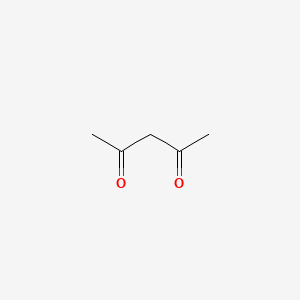| MeSH term | MeSH ID | Detail |
|---|---|---|
| Adenocarcinoma | D000230 | 166 associated lipids |
| Body Weight | D001835 | 333 associated lipids |
| Dermatitis, Contact | D003877 | 59 associated lipids |
| Eczema | D004485 | 4 associated lipids |
| Edema | D004487 | 152 associated lipids |
| Fetal Resorption | D005327 | 15 associated lipids |
| Glioma | D005910 | 112 associated lipids |
| Nervous System Diseases | D009422 | 37 associated lipids |
| Purpura, Thrombocytopenic | D011696 | 2 associated lipids |
| Seizures | D012640 | 87 associated lipids |
2,4-pentanedione
2,4-pentanedione is a lipid of Fatty Acyls (FA) class. The related lipids are Butyrates.
Cross Reference
Introduction
To understand associated biological information of 2,4-pentanedione, we collected biological information of abnormalities, associated pathways, cellular/molecular locations, biological functions, related genes/proteins, lipids and common seen animal/experimental models with organized paragraphs from literatures.
What diseases are associated with 2,4-pentanedione?
There are no associated biomedical information in the current reference collection.
Possible diseases from mapped MeSH terms on references
We collected disease MeSH terms mapped to the references associated with 2,4-pentanedione
PubChem Associated disorders and diseases
What pathways are associated with 2,4-pentanedione
There are no associated biomedical information in the current reference collection.
PubChem Biomolecular Interactions and Pathways
Link to PubChem Biomolecular Interactions and PathwaysWhat cellular locations are associated with 2,4-pentanedione?
There are no associated biomedical information in the current reference collection.
What functions are associated with 2,4-pentanedione?
There are no associated biomedical information in the current reference collection.
What lipids are associated with 2,4-pentanedione?
Related references are published most in these journals:
| Lipid concept | Cross reference | Weighted score | Related literatures |
|---|
What genes are associated with 2,4-pentanedione?
There are no associated biomedical information in the current reference collection.
What common seen animal models are associated with 2,4-pentanedione?
There are no associated biomedical information in the current reference collection.
NCBI Entrez Crosslinks
All references with 2,4-pentanedione
Download all related citations| Authors | Title | Published | Journal | PubMed Link |
|---|---|---|---|---|
| Green TR and Popa R | Turnover of carbohydrate-rich vegetal matter during microaerobic composting and after amendment in soil. | 2011 | Appl. Biochem. Biotechnol. | pmid:21537893 |
| Pircher H et al. | Identification of human fumarylacetoacetate hydrolase domain-containing protein 1 (FAHD1) as a novel mitochondrial acylpyruvase. | 2011 | J. Biol. Chem. | pmid:21878618 |
| Premkumar T et al. | Shape-tailoring and catalytic function of anisotropic gold nanostructures. | 2011 | Nanoscale Res Lett | pmid:21974964 |
| Yang D et al. | Biogenic hierarchical TiOâ‚‚/SiOâ‚‚ derived from rice husk and enhanced photocatalytic properties for dye degradation. | 2011 | PLoS ONE | pmid:21931853 |
| Ran C et al. | Non-conjugated small molecule FRET for differentiating monomers from higher molecular weight amyloid beta species. | 2011 | PLoS ONE | pmid:21559413 |
| Tan M and Lu ZR | Integrin Targeted MR Imaging. | 2011 | Theranostics | pmid:21547154 |
| Babbs C et al. | Duplication of the EFNB1 gene in familial hypertelorism: imbalance in ephrin-B1 expression and abnormal phenotypes in humans and mice. | 2011 | Hum. Mutat. | pmid:21542058 |
| Kumar M et al. | Zinc complexes of Ttz(R,Me) with O and S donors reveal differences between Tp and Ttz ligands: acid stability and binding to H or an additional metal (Ttz(R,Me) = tris(3-R-5-methyl-1,2,4-triazolyl)borate; R = Ph, tBu). | 2011 | Dalton Trans | pmid:21706096 |
| Gasser G et al. | Organometallic anticancer compounds. | 2011 | J. Med. Chem. | pmid:21077686 |
| Röck A et al. | SAM: String-based sequence search algorithm for mitochondrial DNA database queries. | 2011 | Forensic Sci Int Genet | pmid:21056022 |
